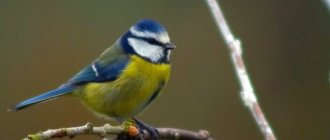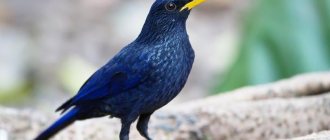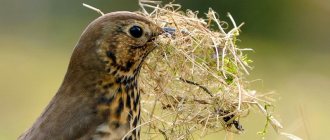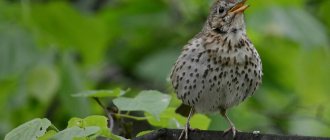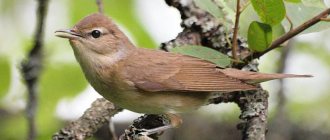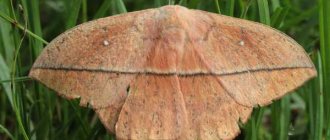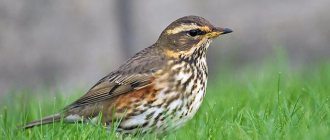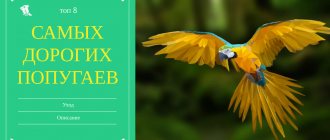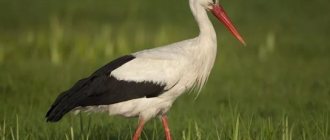mourning cockatoo
A large cockatoo with expressive black plumage with a characteristic yellow spot on the tail. This species is found throughout south-eastern Australia, preferring to live in forested areas.
Black cockatoos are known for their loud calls. They usually make high-pitched contact calls such as "kee-ay...kee-ay...kee-ay". These loud sounds can be heard over a long distance.
The birds live in small groups of 2-3 individuals, and use loud sounds to communicate with each other. Sounds are produced in different tones and strengths. Soft sounds are used when searching for food and during mating games, but loud and sharp sounds warn of danger.
2
Oriole
This bird is incredibly beautiful. Its yellow plumage with black splashes, bright and contrasting, makes an unforgettable impression.
The only negative is that it is almost impossible to see the oriole in the wild; it hides and camouflages itself perfectly in the foliage of trees or grass. However, whoever is lucky enough to see it will be the real lucky one.
The singing of an oriole is something extraordinary. She produces trills that resemble the sounds of a flute, and her singing can be compared with the playing of the greatest virtuoso in the world.
But suddenly the beautiful sounds are replaced by a terrible howl, similar to the screams of March cats - this does not at all mean that the oriole has choked or is now out of voice. This is how she warns her relatives that danger is nearby.
Paradise tanager
Photo source: thibaudaronson, CC BY-SA 4.0, via Wikimedia Commons
Because of their beautiful plumage and melodious singing, these birds are also called paradise tanarga. They live in the tropical forests of Latin America.
They grow no more than 14 centimeters in length, and the plumage is painted in bright colors. The chest is blue, the body itself is red and black, and greenish feathers grow on the head. They have beautiful melodic singing, especially evident during the mating season.
But tanargas are not the only sounds that please the ear. One bird eats a large number of caterpillars per day, thereby saving gardens and forests from pests. In addition to caterpillars, gypsy moth larvae are also eaten with pleasure.
Slender-billed
Distinctive qualities: the beak is thin, long, more or less bent. The fingers are long, especially the hind ones. They feed on insects and flower sap.
Dart frogs (pikas)
They deftly climb trees in search of insects, which they extract from the narrowest crevices. The famous beak helps them with this. The song is a melodic whistle, with a short final “blow”, the current motif is “tzit”, performed in high tones, more like a squeak.
Pikas also include mosquitocatchers and wrens - two numerous subfamilies close to warblers. All of them are wonderful singers, they are called flutists for the purity of their sounds and the richness of their performance.
In the photo there is a mosquito catcher
bird wren
Listen to the voice of the wren:
Honeysuckers and nectaries
In addition to a long beak, they have an elongated tongue, which helps draw out flower nectar. In addition, they feed on insects, fruits and berries. Honeyeaters usually have dark colors, while sunbirds have bright, festive colors, with many pearlescent tones. That’s why their names - malachite, orange-breasted, bronze, purple-bellied, red-throated - all speak of elegant plumage.
House Sparrow
Small and beautiful birds are closely related to people. They have settled almost all over the planet and live in rural and urban areas. Their song contains different types of notes, and they can make sounds in different keys.
There are species of birds in which only males can sing beautifully, but in sparrows both sexes can make sounds. Thus, these social birds communicate with each other. But female house sparrows use such notes very rarely, when the male uses different notes to establish contact and attract a female.
Female house sparrows make a soft chirping sound when a male bird comes into their field of vision. House sparrows also aggressively defend their nest, making loud alarm calls when doing so.
5
Robin
The bird, which has found its way into the lines of Soviet and foreign songs, has a magnificent melodic voice. The singing of a small bird can be heard at dawn. The fact is that during the day they are active, and at night they rest in groups on tree branches.
Robins greet the new day with their singing. The male's song is slightly different from the female's. Males have a wider range. They use not only sounds, take different tones, but also use whistling.
They are called robins precisely because of their habit of singing at dawn. In Great Britain, robins have become a national symbol, and in Russian fairy tales they are a bird of the magical world that brings good news.
6
Night Singers
February 20, 2022
The border between spring and summer is a great time to thoroughly enjoy a variety of bird trills. It is best to listen to the birds at dawn, starting at 4-5 am, when they take turns joining the daytime chorus. At this time, you can count several dozen different songs.
But some birds can only be heard by chance in the early morning, because the main time for their mating occurs at dusk and night. The most famous night singer is, of course, the nightingale. He sings during the day, and at sunset, and in the midst of a short summer night, and at dawn, only occasionally interrupting to sleep and search for food. At night, the nightingale’s singing takes on a special charm, because it is no longer drowned in the hubbub of other birds.
Another night soloist is the robin, or robin, a small bird of the flycatcher family. This bird mainly sings before dawn and at sunset, but even in the dead of night, its pleasant melodic trill can be heard from time to time on the forest edge. Many warblers sing at night. The measured, gentle song of the garden warbler can be heard at the forest edge, in an old park, and even in your own garden. Its trill contains many borrowed sounds, which the warbler intersperses with a characteristic “check-check” call. In meadows overgrown with bushes, on the outskirts of forests or in forest belts, the warbler sings.
The loud trills of marsh and blackbird warblers can be heard near the river. The voices of their relatives - the common cricket and the river cricket - are not so easy to distinguish from the crackling of a grasshopper or cricket. This explains the name of these small graceful birds. At the forest edge or overgrown clearing, you can meet a very interesting singer - the wood lark. He sings in flight, like most of his relatives who solo during the day. The sonorous “yuli-yuli-yuli-yuli” echoes in the darkness over the clearing, but the bird itself is almost impossible to see. This lark has a second name - spinning top, which he owes to his wonderful song.
An amazing nocturnal bird, the nightjar, often lives next to the wood lark. Its rumbling song is reminiscent of the sound of a small motor. The nightjar sings both in the air and while sitting on some dry branch in the open. Sometimes during current flight he flaps his wings loudly several times and then continues his simple song.
Another fan of nocturnal mating lives in damp forests - the woodcock sandpiper. Males sing in groups in the air, occasionally starting fights in flight, and females wait for them on the ground. A crackling “horrr-horrr-horrr” echoes over the forest. This performance is called a “pull”. Woodcocks sing especially actively immediately after sunset and until midnight. In the swamps and water meadows, another sandpiper, the snipe, is shown at dusk. It is known for the low bleating sound it makes due to the vibration of its tail feathers during a sharp descent.
In forests and old parks at night you can hear the voices of some owls - the gray and long-tailed owls, the long-eared owl and the little scops owl. True, the first three species sing not at the end of spring, but earlier, in March-April, and in May-June their chicks are already growing up. One of the characteristic sounds of a June night is the long-drawn, high-pitched whistling-creaking of long-eared owls. It can be heard in the forest, in the park, and in the city yard. The brood wanders, and the grown owlets are found in the most unexpected places.
Water bodies densely overgrown with reeds and reeds are home to our most secretive herons - the great and little bitterns. The voice of the great bittern resembles a drawn-out dull moo, for which the bird received its second name - bull. In calm weather these sounds can be heard several kilometers away. Unaccustomed tourists who decide to spend the night by the lake can be quite frightened by the bittern. The song of the little bittern, or top, is not so remarkable and is a monotonous repetition of the sound “ru”.
Near a swampy pond you can hear the cry of a crake, a member of the rail family. His singing is a rather melodic, repeated abrupt whistle “fit”. The crake, a relative of the crake, lives in floodplain meadows. His cry, an unpleasant loud crackle of “crack-crack,” can be heard both night and day. And the singer himself, who spends most of his life among the thick grass, is very rarely seen.
Quail, a representative of the Galliformes order, often lives in the same meadow as the corncrake, and is also found in fields with cereals or herbs. The fight of a quail - a sonorous "raise-weed" - can be heard far in the silence of the night. Of the birds living near humans, the black redstart is one of the first to wake up. Her simple song can be heard a couple of hours before dawn, and even earlier at the height of the mating season.
Woodcock - Scolopax rusticola
Birds of Siberia
song thrush
The bird, which lives in the forests of Europe, Asia Minor and some regions of North Africa, will amaze anyone with its excellent singing. The thrush's song is leisurely, measured, with a varied set of tones.
The song can imitate the singing of other birds, and some parts of the singing are repeated 2-4 times. They begin to sing at the beginning of the mating season, and the singing continues until the end of the nesting period. They like to settle near cities and villages, and therefore it is easy to hear its beautiful singing.
Collective birds gather on the treetops and begin to sing their songs in chorus. It is noteworthy that they sing in unison and without cacophony.
7
Red-breasted Grosbeak Cardinal
A bright bird of small size and feeding exclusively on seeds, it lives in the northeast and the United States and some regions of Canada. This is a migratory bird and spends the winter among the forests of Tropical America.
Male grosbeaks sing almost always, but especially loudly during the mating season. The female's singing can be heard during the period of nest construction, and then during the incubation period. Grosbeaks, both females and males, have beautiful singing, in which they use different tones and a multiple set of notes.
One of the most beautiful birds in the world with a magnificent voice is on the verge of extinction due to human encroachment on their natural habitat.
8
Oriole
This bird is incredibly beautiful. Its yellow plumage with black splashes, bright and contrasting, makes an unforgettable impression.
The only negative is that it is almost impossible to see the oriole in the wild; it hides and camouflages itself perfectly in the foliage of trees or grass. However, whoever is lucky enough to see it will be the real lucky one.
The singing of an oriole is something extraordinary. She produces trills that resemble the sounds of a flute, and her singing can be compared with the playing of the greatest virtuoso in the world.
But suddenly the beautiful sounds are replaced by a terrible howl, similar to the screams of March cats - this does not at all mean that the oriole has choked or is now out of voice. This is how she warns her relatives that danger is nearby.
Asian Koel
The inhabitant of the Asian expanses is considered one of the best songbirds on the planet. The bird has appeared on the pages of Indian poetry more than once; it was praised for its beauty and magnificent singing, and in China it was worshiped like a deity.
But the koel's habits leave much to be desired. It belongs to the cuckoo order, and therefore lays eggs in the nests of crows and other large birds. In addition, they are carnivorous and, in addition to berries, feed on insects and snails. There were cases when small birds became victims of the koel.
The song of the koel can be heard during the mating season. Males, in order to attract a female, compete in singing incredibly beautiful songs. Loud singing continues between the males fighting for the female until one of them gets tired.
9
Cone-billed
Distinctive qualities: beak is strong, short, conical. They feed on grains, berries, and sometimes insects.
Finches
A very large family, including real professionals in the field of singing. There are finches, and lentils, and bullfinches, and finches, and bee-eaters, and flowerbirds, and grosbeaks, and sicklebills. There are more than 50 species in total. Let's introduce some of them.
Finches feed on seeds and insects and winter in the Mediterranean or Central Asia. They arrive from wintering very early and are often exposed to frost and feel cold, which is why they were named that way.
In the photo there is a finch
The chaffinch's song is characterized by an ornate whistle and a "stroke" at the end - like a calling card.
Canary
The bright songbirds received their specific name in honor of their historical homeland - the Canary Islands. Over time, man domesticated canaries and they became beloved pets, also filling the house with beautiful singing.
They belong to the genus of finches, and the first canaries born in captivity were born in the middle of the 17th century. Spanish sailors brought them to Europe on their ships. Favorite birds of Spanish and English monarchs.
Their abilities are truly unique, as canaries can learn the notes of any song if they deliberately teach this song to them. The only period of life when they do not sing is the season of shedding their feathers. And this happens every year in the summer months. TopCafe wishes you to hear the song of this amazing bird at least once.
10
Western Nightingale
A small bird from a huge order of passerines is one of the most famous singers of our planet. The nightingale's mesmerizing song is a series of repeated clicks and whistles that form a beautiful melody.
Each element of the nightingale song, which is called a “knee,” can be repeated up to 12 times. He may scream loudly, but his scream is a rather low-pitched “fiuit-trrr.” Experts from various fields of science agree that the nightingale song is the most beautiful natural sound of nature.
Nightingales have settled all over the planet, and the expanses of the European north are considered their homeland. From this part of the planet they settled to other continents.
